Aviation Meteorology: Decoding the mechanics of Atmospheric Pressure

All of our readers must be pondering over this one comprehensive blog for comprehending atmospheric pressure. Although it may appear to be a relatively straightforward subject, it holds paramount importance in the field of aviation.
We strongly believe that a comprehensive understanding of this concept is crucial for aspiring aviation professionals, whether you're a pilot, cabin crew member, ATC controller, or anyone directly or indirectly associated with aviation.
This knowledge about atmospheric pressure might prove invaluable at any given moment, potentially even saving lives. Unlike other platforms that provide only a brief overview of specific topics, we have delved deep into this matter.
We sincerely thank you!
For those who are new to our blog, remember to register at AviationX (Your Destination for All Things Aviation). The registration process takes just a minute. And yes, upon finishing the blog, there's a quiz waiting for you(icon on the right as well)
While some of our readers might find the topic easy and think they know it all, we encourage you to take the quiz. The quiz is designed to complement your post-reading experience, ensuring a comprehensive learning journey. For any score below 100%, we recommend readers to dedicate some time to read or re-read the blog.
To begin the quiz, click the button below or the quiz icon on the right sidebar.
So Let's get started!
The higher we soar, the smaller we appear to those who cannot fly
Friedrich Nietzsche
Atmospheric pressure, often referred to as air pressure, is the force exerted by the weight of the Earth's atmosphere on a unit area at any given point on its surface. This pressure is a result of the gravitational attraction between the Earth and the gases that make up the atmosphere, primarily nitrogen and oxygen. As one ascends higher into the atmosphere, atmospheric pressure decreases due to the reduction in the density of air molecules above.
Atmospheric pressure plays a significant role in various natural phenomena, such as weather patterns, and is a crucial factor in aviation, meteorology, and other scientific fields. It is commonly measured in units like millibars (mb) or pascals (Pa).
Some important pressure conversions given below
Static and Dynamic Pressure: Understanding the Difference
When air is stationary, its molecules exhibit random motion throughout. The pressure exerted by these molecules remains uniform in all directions, resulting in what is known as Static Pressure or Barometric Pressure.
However, when the air is in motion, an extra pressure is applied in the direction opposite to the flow. This phenomenon is referred to as Dynamic Pressure or Wind Pressure. Wind Pressure plays a crucial role in the design of devices like airspeed indicators.
Pressure: The Result of Air's Weight Above

Circling back again At any given level, atmospheric pressure can be understood as the weight of the air column with a unit cross-section that extends vertically upwards to the outermost layer of the atmosphere. As altitude increases, the weight of this column decreases, leading to a corresponding decrease in pressure.
Changes in air pressure are responsible for the sensation of ears popping, especially when traveling across terrains with significant elevation variations or during the rapid descent of an aircraft.

To read the complete blog subscribe to our premium subscription plans